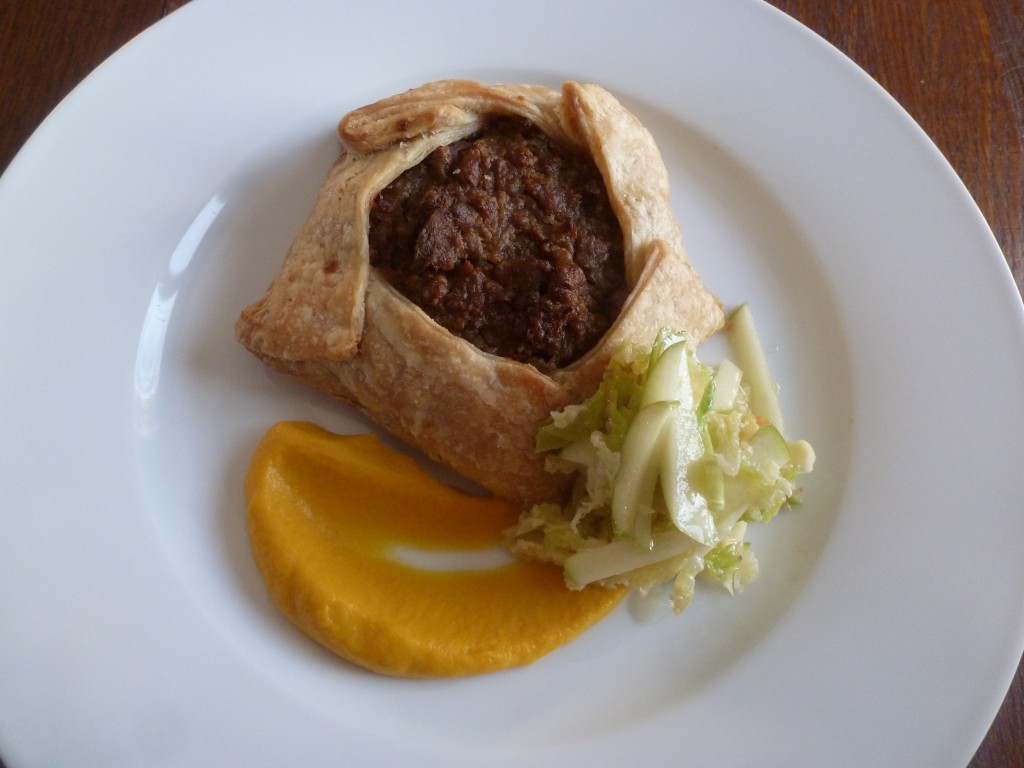 Tourtière is made differently in every home, and can incite intense feelings of loyalty to ones mother. I will proceed cautiously with a definition, but I warn you: there are lots of qualifiers in this post.
Tourtière is made differently in every home, and can incite intense feelings of loyalty to ones mother. I will proceed cautiously with a definition, but I warn you: there are lots of qualifiers in this post.
Tourtière is meat pie. It is often based on pork, though veal and game are also common. If anyone tells you that it was traditionally made with pigeon, you can politely dismiss their story as folklore. A false etymology has developed because of the similarity between the words for the pie tourtière and the Quebecois word for the now-extinct passenger pigeon, tourte. Certainly many a pigeon has been baked into pie, but the similarity between the two words is entirely coincidental. Tourte also happens to be an old French word for pie, both sweet and savoury, and the dish that a tourte is cooked in is called a tourtière.[1] In Quebec the name of the baking dish became the name of the pie itself.
So I can safely add another component to our definition of tourtière: it is baked in a dish.
The meat can be either ground or cubed. I nervously propose that it is usually ground, though in one famous regional variation, the tourtière du Lac-Saint-Jean, the meat is always cubed.
The meat, whether pork or veal or game, and whether ground or cubed, is usually flavoured with spices like cinnamon and clove. This trait is rarely disputed.
To my mind, what makes tourtière really special, and what really distinguishes it from English pork pie, is that the meat is usually cooked before it is put in the pie, then bound together with potatoes or some manner of sauce.
The English pork pies I’ve eaten are made like this: mix raw, ground pork with onions and spices; shape the raw meat mixture into a disc; wrap pie dough around that disc; bake until the meat is cooked and the crust is golden brown. The good things about this method are that the interior is very cohesive and the pie is easy to slice. The bad things about this method are that the meat never gets browned, and frankly the cohesive, springy interior can be a bit boring, texturally.
With tourtière, the meat can be thoroughly browned in a heavy pan before being stuffed into pastry. The interior is therefore caramelized, with lots of textural contrast (imagine little nuggets of pork). The trade-off is that it is not very cohesive, and can be difficult to slice and present cleanly. The simple solution is that the interior must be bound together somehow.
The final important characteristic of tourtière is that it is a festive dish meant to be shared by many people. It is an essential component to a Quebecois réveillon. The baking- and serving-vessel is usually quite wide and deep so that at least eight, possibly as many as sixteen, people can be served from it.
Okay. Now that we’ve delicately explored the nebulous world of traditional tourtière, let me share my own not-so-traditional version.
I use pork. This is a no brainer. It’s flavoured lightly with cinnamon and clove, and it’s browned heavily in a pan, because that makes pork delicious, and makes for an interesting texture. I forgo the stodgy potato binder and make a thick sauce with cider, pork reduction, and roux.
The real departure from tradition is that I like making “individual tourtières,” baked without the support of a pie-plate. I know that by simple definition a tourtière must be baked in a dish. I know this. But doesn’t tourtière look cute as a little, star-shaped, personal, free-form pie, served with smooth-as-sin pumpkin purée and Savoy cabbage slaw?
Reference
1. Various Authors. Larousse. © 2001 Clarkson Potter Publishers, New York, NY. Page 1229.
Other Sources
An amusing discussion on what makes an “authentic tourtière” in this old CBC Radio show.
